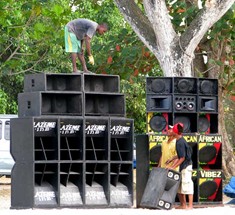 During my guest stint over at Ta-Nehisi’s place last week, a commenter reminded me of my all-time favorite Otto von Bismarck quote: “Politics is the art of the possible.” The unsmiling German statesman may have meant that all successful negotiations must end in compromise, but I’d like to think he also had faith in politics’ ability to tease out technological innovation. Politicians are useless without the means to communicate with the masses, of course, and so they must constantly be on the lookout for new methods of spreading their messages. And that is where the geeks take over.
During my guest stint over at Ta-Nehisi’s place last week, a commenter reminded me of my all-time favorite Otto von Bismarck quote: “Politics is the art of the possible.” The unsmiling German statesman may have meant that all successful negotiations must end in compromise, but I’d like to think he also had faith in politics’ ability to tease out technological innovation. Politicians are useless without the means to communicate with the masses, of course, and so they must constantly be on the lookout for new methods of spreading their messages. And that is where the geeks take over.
That is precisely what happened in Jamaica in 1949, shortly after the introduction of universal adult sufferage. For the first time, politicians were forced to address mass gatherings, a task that could only be accomplished with the aid of amplification technology. The main beneficiary of this development was a Kingston radio geek named Horace Leslie Galbraith, who had spent World War II in Britain working as a radar technician. Upon his return to Jamaica, he was the island nation’s pre-eminent electronics expert, and was thus enlisted by politicians to build 25-watt amplifiers that could be run off 12-volt car batteries—the only reliable means of ensuring that one’s voice could be heard while standing atop a car in front of thousands of onlookers.
Galbraith soon found, however, that his expertise was even more in demand among artists than politicians, as he recently explained to the Jamaica Observer:
“From the early thirties to the fifties there were exclusive clubs in Kingston with live orchestras led by George Moxey, Redver Cooke and Mapletoft Poulle, amongst others, which were patronised by the St Andrew well-to-do. For us ordinary people there were no live orchestras but, instead, large homes on Victoria Avenue, upper King Street and elsewhere, where they hired a radio phone with popular 78rpm records and the patrons paid from two to five shillings entrance fee,” Galbraith recounted.
“But the music from the scratchy 78rpm records at a radio phone dance was very poor and could only be heard by about 20 people. The sound quality needed to be improved. The music had to be enhanced — less noise, more clarity, “rounder” bass, voices to be brought out — and more power was needed. Having built the 25 watt amplifiers, I was sure I could build a better amplifier to improve our radio phone dances and set out to do so,” he stated.
Admitting that his trailblazing amplifier exceeded his expectation Galbraith concluded, “This first, ground-breaking model was sold to Tom Wong and was used to start his sound system called Tom the Great Sebastian. Within a few months there were sound system dances all over Kingston at various lodge halls, open air lawns and anywhere that could hold a crowd of 100 people and up. We supplied amplifiers to sound systems all over Kingston and the country parishes. Among the sound systems we supplied amplifiers to were Nicks, Prof, V Rocket, Hoshue, Duke Reid, Coxsone Dodd (Downbeat) and many others all over Jamaica.”
Galbraith probably didn’t foresee how sound systems would eventually grow into Goliath-sized stacks, nor go mobile atop bikes. But such things did eventually become possible, and it all loops back to some politicians’ yen to get elected. Smart guy, that Bismarck. Though he looks like he could probably have used more hugs.


scottstev // Jul 27, 2010 at 11:03 am
It’s fascinating to find out the roots of such traditions. I knew that Jamaicans loved their sound systems, and that bass duels are a common occurrence, but it’s fascinating to see how culture influences technology only to have said technology become a part of the culture.
Jordan // Jul 27, 2010 at 2:15 pm
Who would have thought that Jamaican politics would be one of the root causes of hip-hop.